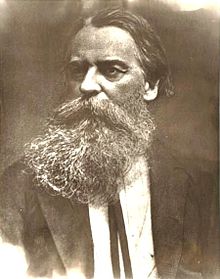Thomas Baines

John Thomas Baines (born November 27, 1820 in King's Lynn , England , † May 8, 1875 in Durban , South Africa ) was an English artist and explorer . He mainly toured the British colonies , southern Africa and Australia .
Life
Born in King's Lynn, Norfolk , Thomas Baines learned from a painter at an early age. Inspired by George French Angas (1822–1886) and William Cornwallis Harris (1807–1848), he left England for South Africa at the age of 22 on board the Olivia , whose captain was a family friend, and worked in Cape Town as a landscape and portrait painter . Already at this time he undertook his first expeditions to what is now Namibia and Botswana . During the first two years of the eighth border war of the British against the Xhosa (1850 to 1853) he worked as a painter for the British army.

In 1852 Baines returned to his hometown, where he exhibited his works and passed on his experiences in lectures. He attended the Royal Geographical Society to discuss his experiences from his travels with geographers such as John Arrowsmith (1780–1873).
In 1855 Baines joined Augustus Gregory and accompanied him until 1857 on an expedition through northern Australia sponsored by the Royal Geographical Society as a painter and material manager. The aim of the expedition was to explore the Victoria River in the Northern Territory to determine its suitability for colonial settlement. His work on the North Australian Expedition was the highlight of his life. As a thank you and honor for his work during the expedition, Mount Baines and the Baines River were named after him.
After returning from Australia, Thomas Baines became a member of the Royal Geographical Society . In 1858, Baines accompanied David Livingstone on his expedition along the Zambezi , making him one of the first Europeans to see Victoria Falls . However, the collaboration with Livingstone ended in a debacle when he was unjustifiably accused of theft and was sent back to Cape Town.
From 1861 to 1862, Baines went on an expedition with James Chapman through what is now Botswana and Namibia . In 1861 he painted a group of baobabs in the area of today's Nxai-Pan National Park , which still exist today and are called Baines Baobabs . In 1864 he went again on an expedition to southwest Africa. In 1869 he led an expedition in search of gold in Mashonaland (now part of Zimbabwe ). In 1871 Baines received a concession from Matabele King Lobengula to search for gold in the region between Gweru and the Hunyani Rivers.
Thomas Baines died in 1875 at the age of 55 years in Durban ( colony of Natal ) of dysentery. In the South African province of Eastern Cape , a nature reserve, the Thomas Baines Nature Reserve , was named after him in his honor. The same applies to the Baines nunatak in the Antarctic.
Works
Thomas Baines is known for his detailed paintings and sketches of landscapes and life in the colonies. Many of his images can now be found in the National Library of Australia , the National Archives of Zimbabwe , the National Maritime Museum in Greenwich , the Brenthurst Library in Johannesburg and the Royal Geographical Society in London.
literature
- Thomas Baines, Explorations in South-West Africa: being an account of a journey in the years 1861 and 1862 from Walvisch Bay, on the Western Coast to Lake Ngami and the Victoria Falls (London: Longman, Green, Longman, Roberts, & Green , 1864).
- Thomas Baines, The gold regions of south eastern Africa (London: Edward Stanford, 1877).
- JPR Wallis (ed.), The northern goldfields diaries of Thomas Baines (London: Chatto & Windus, 1946).
- Fay Jaff, They came to South Africa (Cape Town: Timmins, 1963).
- JPR Wallis, Thomas Baines, his life and explorations in South Africa, Rhodesia and Australia, 1820-1875 (Cape Town: AA Balkema, 1976).
- Russell Braddon, Thomas Baines and the North Australian Expedition (Sydney: Collins in association with the Royal Geographical Society, 1986).
- Jane Carruthers and Marion Arnold, The life and work of Thomas Baines (Vlaeberg, South Africa: Fernwood Press, 1995).
- Historic Houses Trust, Cape Town, halfway to Sydney 1788-1870: treasures from The Brenthurst Library Johannesburg (Sydney: Historic Houses Trust, 2005).
- William Barry Lord lavishly illustrated by Thomas Baines Shifts and Expedients of Camp Life, Travel and Exploration (1876)
- THOMAS BAINES of KING'S LYNN, Artist and Traveler. by Henry J. Hillen. serialised in "THE KING'S LYNN NEWS and NORFOLK COUNTY PRESS" published between March 12th and September 10th 1898. Transcribed copies are in the King's Lynn Library, and Museum.
- Mathias Guenther: "Poor Baines has his troubles ...". Thomas Baines and James Chapman afoot in the Kalahari, 1861 - Deconstructing an imperialist narrative. In: Namibia Scientific Society / Namibian Scientific Society Journal, no. 55, 2007, p. 85-107.
Web links
- Baines work in the National Library of Australia, Canberra
- Baines work at the National Maritime Museum, Greenwich
- Thomas Baines in Google Arts & Culture
Individual evidence
- ↑ a b c Raymond John Howgego: John Thomas Baines ( Memento of the original from June 30, 2007 in the Internet Archive ) Info: The archive link was automatically inserted and has not yet been checked. Please check the original and archive link according to the instructions and then remove this notice.
- ↑ a b c Jane Carruthers, Thomas Baines: Artist-Explorer of Australia and Southern Africa, NLA News, October 2005, Volume XVI, Number 1
| personal data | |
|---|---|
| SURNAME | Baines, Thomas |
| ALTERNATIVE NAMES | Baines, John Thomas (full name) |
| BRIEF DESCRIPTION | British landscape painter and Africa explorer, member of the Royal Geographical Society |
| DATE OF BIRTH | November 27, 1820 |
| PLACE OF BIRTH | King's Lynn , England |
| DATE OF DEATH | May 8, 1875 |
| Place of death | Durban , South Africa |

